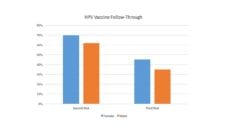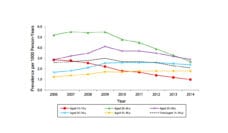In July of 1952, US health officials were in full swing combating the then-regular spike in summer polio cases. As the virus spread through communities, parents were urged to keep their children in quarantine. Pools were vacant. Movie theaters shut their doors. Desperate officials recommended stopping drains fearing disease spread through sewer air. Days of mild illness progressed into loss of limb control. Patients were placed in hot packs of wet wool and casts to prevent muscles spasms. By winter many had recovered, 21,000 were paralyzed, and more than 3,000 (mostly children) were dead.
The following May, Jonas Salk injected himself and his family with an experimental vaccine that would eventually bear his name. By 1954 the vaccine was being distributed to children across the country and within three years, cases of paralytic polio dropped by 75%. In 1964, the number of cases reported was under 100–a 99.5% reduction.
Vaccination works. It has worked, it’s working now, and it will continue to work better as new tools are developed. It works because of courageous policy, community buy-in, and dire alternatives. Vaccination is also opaque, technical, and prone to misunderstanding and misinformation. It’s not surprising that vaccination campaigns since the 19th century have received continuous pushback as concerns about safety and questions of efficacy (rightfully) weigh in. However, the high stakes breed zealotry. Legitimate fears have been scientifically addressed, but entrenched anti-vaccine leadership ignores the science and is effectively reframing the discussion around personal freedom.
Many of our most important public debates center around the preservation of personal freedoms. From gun rights to abortion rights, most legislators are highly trained to value autonomy over collective good–asking them to restrict parental choice over their child’s medical treatment is a heavy lift. Small, well-funded, vocal communities wield this unease effectively in a gambit to undermine the legitimacy of a keystone of community vaccination strategies: herd immunity.
Herd immunity is a conceptual flashpoint in the debate. Appropriation of the phrase is common, but its original meaning is simple. If an infected individual is dropped into a community, how densely protected must the community be in order to prevent the infection from taking root and spreading? That protection threshold is easily calculated if you know how fast an infectious agent spreads. In the case of measles (highly infectious), the number is between 92% and 96%. If vaccination coverage in a community is under 95%, the disease will penetrate and develop. If coverage is higher, it will not.
Vaccination works. It has worked, it’s working now, and it will continue to work better as new tools are developed.
Vaccines are effective, but imperfect. The mumps component of the MMR vaccine has a 12% non-responder rate. Rephrased, 12% of our vaccinated citizens are not protected. So why don’t one in 10 of us get the mumps? We simply aren’t exposed. Our community is herd-immune and one-off community mumps exposures don’t expand–those 12% are protected through community commitment to vaccination. Are you in that 12%? When did you last check your titers?
Vaccines also require healthy, developed immune systems to mediate protection. As a result, many of our most vulnerable citizens cannot be effectively vaccinated, relying entirely on non-exposure for protection. These include: infants, the elderly, the immunocompromised (people living with HIV), and the immunosuppressed (cancer patients and transplant recipients). It is the core goal of a successful vaccination program to ensure passive protection of our babies, sick, and elderly by preventing infectious disease from penetrating our communities.
The implications of herd immunity are challenging from the perspective of community responsibility. If you choose not to vaccinate, you are partially responsible for your neighbor’s infant losing their hearing from measles complications. This is why the debate around herd immunity is so inflamed, and why the anti-vaccine movement insists it must not be true–a lie told by a pro-vaccine/pharma kabal.
But herd immunity is true. Pretending it isn’t risks losing it. That’s why, as policy professionals, we cannot accept the “my body my choice” narrative as legitimate. Vaccination programs are not personal healthcare choices. They are decisions made by a community to protect their most vulnerable, and rely on leadership to inform, persuade, and, when necessary, compel. Controlling the public narrative is a critical component of that process – we must maintain focus on the population that needs protection rather than the population that makes the most noise.
Photo by Hans Heiner Buhr on Unsplash














